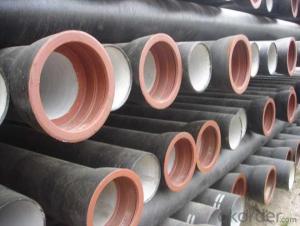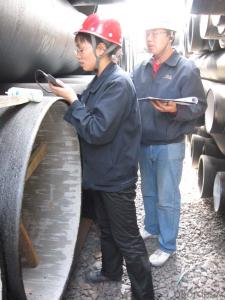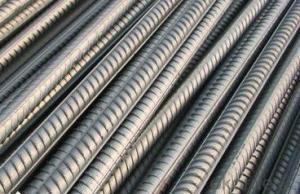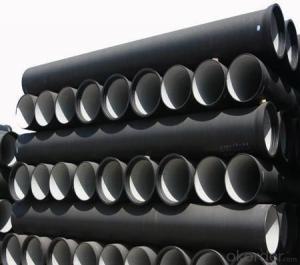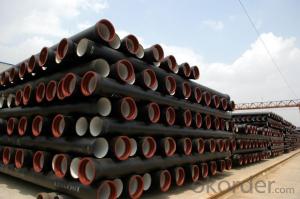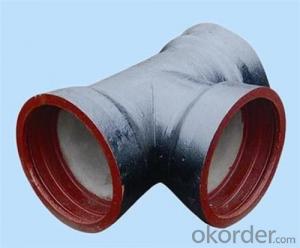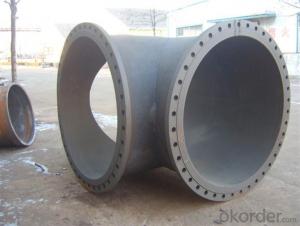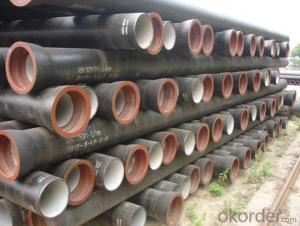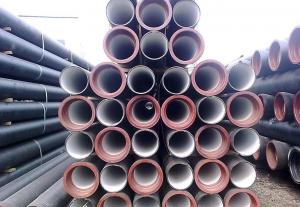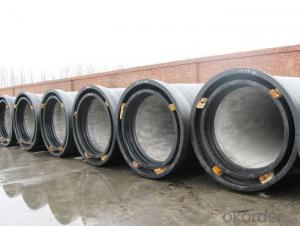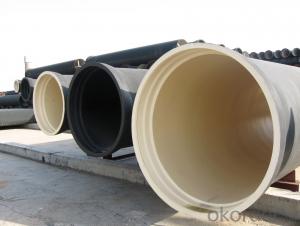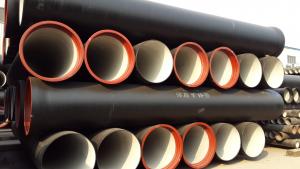Ductile Iron Pipe EN545 DN300 High Quality
- Loading Port:
- China main port
- Payment Terms:
- TT OR LC
- Min Order Qty:
- 999 m
- Supply Capability:
- 9999 m/month
OKorder Service Pledge
OKorder Financial Service
You Might Also Like
1,Ductile Iron Pipe Description :
1) Pipes confirm to ISO2531,K9 class,T type joint,6m long,with inside cements lining conform to ISO4179, outside Zinc spraying(130g/m2) and bitumen coating(70μm) conform to ISO8179.
2) Pipe ends: Spigot and socket ends, with 100% SBR rubber gaskets accoding to ISO4633
3) we can do third party inspection according to customer's request.
2,Main Features of the Ductile Iron Pipe:
1. Material: Ductile iron grade 500-7/ 450-10 in accordance with ISO1083
2. Standard: ISO 2531, EN545, EN598, ANSI, AWWA
3. Certificate: ISO9001, ISO14001, SGS, NSF, WRAS
4. Test: In accordance with ISO 2531 / EN 545 / EN598 and 100% water pressure test
5. Internal Lining: Cement, conform to ISO4179
3,Ductile Iron Pipe Images:

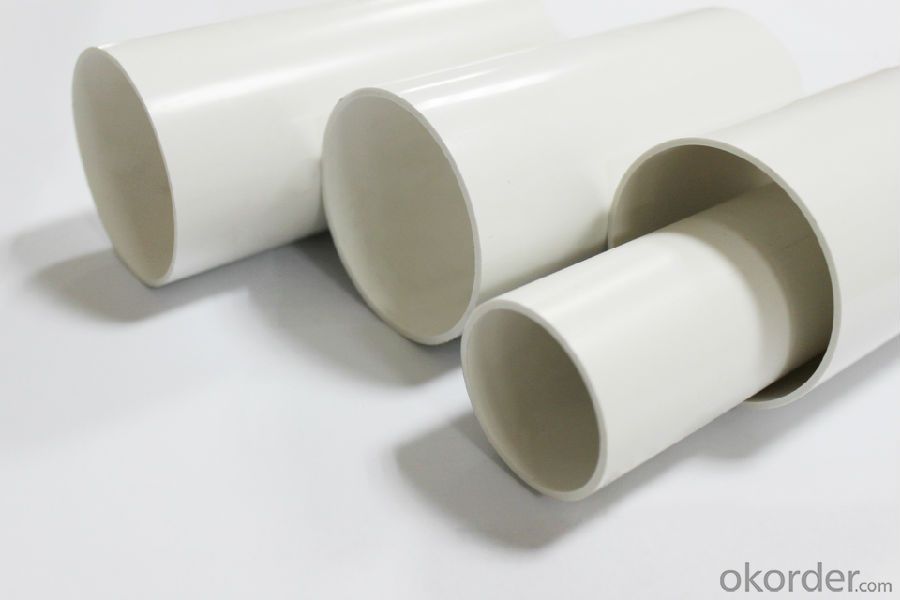
4. Ductile Iron Pipe Specification
Standard: API SPEC 5L 44th eidtion,ASTM A252-98(2007)
Grade: A53 Grades A/B, ASTM A106 Grades B/C,ASTM A179 AWWA, C200, ASTM A139, ASTM A120, X42, X52, X56, X60, X65, X70, X80, X100
Weld Alternatives: LSAW
OD size range: 6.4~44.5mm
Wall thickness: 406.4~1422mm
Length: 3-12 m according to requirment
Note: Other grade can also be provided after consulting. Special design are available for coal slurry conveyance LSAW line tube -- Service
5.FAQ:
1.Q: Why would you choose ductile iron pipe rather than other pipe materials?
A:The reasons are obvious for that not only ductile iron pipe possesses the inherent strength and flexibility of ductile iron, combined with proven corrosion protection systems, but also the cost savings can be achieved from design to installation and commissioning.
2.Q:Why can you guarantee the inner of pipes can’t be corroded?
A: High alumina cement mortar lining and sulphate-resistant cement mortar lining. These two special linings are applicable to inner anti-corrosion for sewage pipes, improving resistance to erosion of the sewage components.
- Q: Are ductile iron pipes resistant to soil movement?
- Yes, ductile iron pipes are generally resistant to soil movement due to their high tensile strength and flexibility. They can withstand ground settlement, soil shifting, and other forms of soil movement without experiencing significant damage or failure.
- Q: What are the different joint restraint systems available for ductile iron pipe?
- Some of the different joint restraint systems available for ductile iron pipe include mechanical joint restraints, push-on joint restraints, and restrained joint systems.
- Q: Can ductile iron pipe be used for underground fire protection systems?
- Yes, ductile iron pipe can be used for underground fire protection systems. Ductile iron is known for its strength, durability, and corrosion resistance, making it a suitable material for such applications. It can withstand high pressures and temperatures, ensuring reliable and long-lasting performance in underground fire protection systems.
- Q: What are the common methods for leak detection in ductile iron pipes?
- Professionals in the field commonly utilize various techniques to detect and locate leaks in ductile iron pipes. These methods play a crucial role in timely leak identification. 1. Acoustic Leak Detection: By employing specialized equipment, professionals listen for the sound of water escaping from the pipe. This equipment detects the leak's sound and aids in pinpointing its exact location. This technique is effective for both pressurized and non-pressurized pipes. 2. Visual Inspection: Physically inspecting the pipe system for visible signs of leaks, such as water stains, wet spots, or puddles, constitutes visual inspection. This relatively straightforward method proves effective in detecting visible leaks in accessible areas. 3. Pressure Testing: During installation or maintenance, pressure testing involves pressurizing the pipe system and monitoring pressure drops. A decrease in pressure signifies the presence of a leak. This method is particularly useful for identifying leaks in inaccessible areas. 4. Infrared Thermography: Infrared cameras detect leaks by measuring temperature variations. The camera can identify temperature differences caused by water escaping from a pipe. This technique is especially efficient in identifying concealed leaks behind walls or underground. 5. Tracer Gas Testing: Tracer gas testing entails injecting a specific gas, such as helium or hydrogen, into the pipe system. In the event of a leak, the gas escapes and can be detected using specialized equipment. This highly sensitive method can locate even minute leaks. 6. Soil Gas Monitoring: Monitoring the soil surrounding the pipe allows professionals to detect gases emitted by leaking water. Analyzing the composition of the soil gas aids in determining the leak's location. It is essential to consider the specific circumstances, such as pipe system size, accessibility, and leak severity when selecting a method. Combining multiple techniques may be necessary to ensure accurate and comprehensive leak detection.
- Q: What are the typical joint sealing requirements for ductile iron pipes?
- The typical joint sealing requirements for ductile iron pipes include the use of rubber gaskets or mechanical joints. Rubber gaskets are commonly used for joint sealing in ductile iron pipes as they provide a reliable and flexible seal. These gaskets are typically made of synthetic rubber materials that are resistant to water, chemicals, and other environmental factors. Mechanical joints, on the other hand, are another common method of joint sealing in ductile iron pipes. These joints consist of a mechanical device that connects the pipes together and provides a watertight seal. Mechanical joints are typically designed to allow for some movement and flexibility, which is especially important in areas where ground movement or settlement may occur. In addition to using rubber gaskets or mechanical joints, it is also important to properly clean and prepare the pipe surfaces before making the joint. This may involve removing any dirt, debris, or old joint material from the pipe ends to ensure a proper seal. The joint should then be assembled according to the manufacturer's instructions, ensuring that the gasket or mechanical joint is correctly positioned and tightened to the recommended torque. Overall, the typical joint sealing requirements for ductile iron pipes involve the use of rubber gaskets or mechanical joints, proper cleaning and preparation of the pipe ends, and following the manufacturer's instructions for assembly. These requirements are essential for ensuring a watertight and durable joint that can withstand the pressures and environmental conditions commonly encountered in ductile iron pipe systems.
- Q: Deep well spiral iron pipe, or ductile iron tube?
- Ductile weakness: ductile cast iron pipes connected by human factors such as the operation level of responsibility, influence, construction not convenient. The advantages of PE PE PE pipe has good corrosion resistance and its anti inorganic performance than that of the metal pipe is much stronger in the buried without corrosion, construction convenient. Small diameter PE pipe in the price performance ratio is better than that of steel and ductile iron.PE tube have disadvantages: benzene, gasoline, carbon tetrachloride and other organic solvents have certain effect on pe. If the organic solvent is infiltrated into the polyethylene, the swelling will occur, and its physical properties will be decreased. Its pressure resistance and temperature resistance are poor.
- Q: How do we handle the leaking of the ductile iron pipe?
- A hoop is a component that holds or ties another material with one material. It belongs to the fastener. The hoop holding device is composed of a hoop plate, a wing plate, a tension tie plate, a bolt and an inner liner. There are many kinds of hoop, hoop cable, wire rod hoop, hoop cable, wire hoop, stainless steel hoop are commonly used.
- Q: Can ductile iron pipe be used in high-pressure applications?
- Yes, ductile iron pipe can be used in high-pressure applications. Ductile iron pipe is known for its strength and durability, making it suitable for a variety of applications, including high-pressure systems. It has a higher tensile strength and yield strength compared to other types of cast iron pipes, allowing it to withstand higher pressures. Additionally, ductile iron pipe is resistant to corrosion and can maintain its structural integrity even under high-pressure conditions. However, it is important to ensure that the pipe is properly installed, and all necessary safety measures are followed to ensure the safe and efficient operation of the high-pressure system.
- Q: Usage of ductile iron pipe expander
- Spheroidal graphite iron expander, also known as cast iron telescopic device, is a new type of pipe connector.
- Q: Are ductile iron pipes suitable for water distribution networks?
- Ductile iron pipes are a suitable choice for water distribution networks. They have been widely used in water distribution systems for many years, thanks to their numerous advantages. To begin with, ductile iron pipes possess excellent durability and a long lifespan. Their resistance to corrosion is crucial for water pipes since they are continuously exposed to various chemicals and substances in the water. This corrosion resistance ensures that the pipes maintain their structural integrity over time, reducing the frequency of repairs or replacements. Furthermore, ductile iron pipes have a high strength and can withstand high pressure, making them ideal for water distribution networks. They can handle heavy loads and resist external forces such as soil movement or traffic loads, guaranteeing the safety and reliability of the water supply. Moreover, ductile iron pipes exhibit excellent hydraulic properties. With their smooth internal surfaces, they minimize friction and pressure drop, enabling the efficient flow of water through the system. This aids in conserving energy and reducing pumping costs, making ductile iron pipes a cost-effective choice for water distribution networks. Additionally, ductile iron pipes are versatile and can be easily installed in various soil conditions. They can endure ground movement and settle without breaking, which is crucial for maintaining a stable water distribution system. In conclusion, ductile iron pipes are highly suitable for water distribution networks due to their durability, resistance to corrosion, high strength, excellent hydraulic properties, and versatility in installation. They offer a reliable and efficient solution for delivering safe and clean water to communities.
Send your message to us
Ductile Iron Pipe EN545 DN300 High Quality
- Loading Port:
- China main port
- Payment Terms:
- TT OR LC
- Min Order Qty:
- 999 m
- Supply Capability:
- 9999 m/month
OKorder Service Pledge
OKorder Financial Service
Similar products
Hot products
Hot Searches
Related keywords
